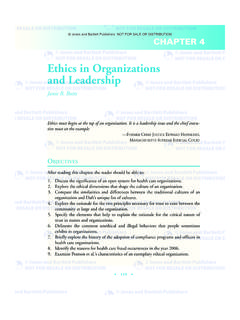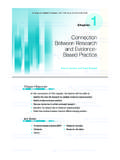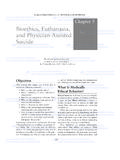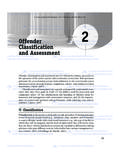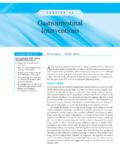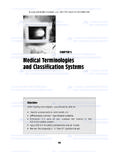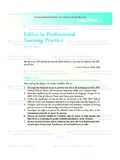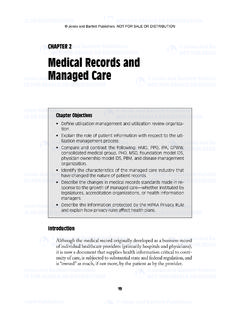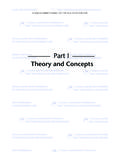Transcription of Part I
1 part ITheories of Leadership and ManagementTheories and Styles of Leadership1 Theories and Styles of Management2 Jones and Bartlett Publishers. NOT FOR SALE OR DISTRIBUTION Jones and Bartlett Publishers. NOT FOR SALE OR DISTRIBUTION1chapterTheories and Styles of Leadership3 ChaPTer ObjeCTIveSAfter reading this chapter, answering the leadership challenges, and par-ticipating in the leadership development exercises, you will be able to:Critically analyze one leadership situation List environmental and organizational trends Describe four leadership theories Differentiate transformational leadership from authentic leadership Describe two leadership theories that are especially important to nursingAssess your own transformational and authentic leadership qualities Discuss an emerging view of leadership Evaluate your own ability to be an adaptable leader Apply leadership theories to a simulated clinical setting Advanced nurses will be able to.
2 Teach at least three advanced nursing students about four leadership theoriesDesign a problem statement for a research study focused on one leadership theoryDevelop a research design to answer your problem statement Jones and Bartlett Publishers. NOT FOR SALE OR DISTRIBUTIONI ntroductionNurse leaders empower themselves and others to help achieve organizational goals. Nurse leaders at all levels, from students to the chief executive officer, are in key positions to participate in decision making that affects client care. This means you have the opportunity to exhibit nursing leadership qualities in your clinical work. This book will help you begin to broaden your outlook from a single client to a nursing unit and nurse leaders use leadership theory and principles to guide their actions. This chapter introduces such theories and suggests ways to use them in nursing situations to empower staff.
3 This chapter, and all others, begins with a short Leadership in Action vignette of a real-life nursing situation and contains a series of leadership challenges, tips, and development exercises to help you understand theories and apply them in clinical settings. When you come to a challenge question, take a moment to think about what you just read, and answer it. This will help you anchor leadership information in your mind, making it accessible for use later on. LeaderShIP In aCTIOn Mrs. Moore, an LPN, has been working in an outpatient clinic for 15 years. Head nurses, physicians, and administrators have come and gone, but Mrs. Moore has stayed. She is a verbal, well-organized, and defiant member of the nursing team. Mrs. Moore does things her way and rarely follows policy. She has helped many staff members and has friends throughout the city who keep her apprised of upcoming changes.
4 As an informal leader with a great deal of influence, she typifies the reality that exists in many nursing arenas. Although she has little formal power or influ-ence, she can be thought of as a nurse leader and part of a sphere of healthcare ChaLLenge What kind of leadership challenges might Mrs. Moore present for a new nurse leader?What Is Creative Nursing Leadership?Leadership is one of the major factors, sometimes the only factor, that deter-mines whether an organization succeeds or fails (Simkins, 2005). As a nurse leader, you will be called on to use all your knowledge and problem-solving skills to find creative solutions to healthcare situations, such as the one presented by Mrs. ChapTer 1: Theories and Styles of Leadership Jones and Bartlett Publishers. NOT FOR SALE OR DISTRIBUTIONC reative leadership involves not just imitating what is already in effect; it includes producing or inventing new solutions to challenging situations and using imagination and skill to apply relevant theory and trends make creative nursing leadership a necessity.
5 As nursing situations and the world itself become more complex, so does being a leader. To function as a cre-ative nurse leader, you must familiarize yourself with the many theories and forms of leadership. As you ve probably noticed, leaders don t necessarily have to be formally appointed. Mrs. Moore, the LPN at the beginning of this chapter, is a good example. You can be an informal and creative leader in whatever position you are in even if you are a student. You can demonstrate creative leadership when you use your knowledge, personal power, and individual traits to teach a client a skill, to show a family how to do aftercare, to help a client communicate effectively with a physician, or to petition politicians to promote health and be a creative nurse leader, you need to be aware of healthcare trends that can affect your practice.
6 What are some of these trends? Consider the following:Advances in information technology A focus on quality Globalization Growth in service-based organizations Organizational changes also demand creative nursing leadership. Some of the changes that can challenge you are the increased diversity of staff and clients, the movement from formal leadership to self-managed teams, and nurse leaders who also serve as sponsors, team leaders, and internal kind of creative nursing leadership do these trends and organizational changes require? Nurse leaders who hope to succeed may need to be especially creative when they assume roles that demonstrate the following competencies:Technology master Problem solver Ambassador Change maker Great communicator Team player LeaderShIP ChaLLenge Which of these roles, if any, does Mrs.
7 Moore, the LpN, exemplify? Key TerMCreative leaders produce or invent new solutions by using imagination, skill, and relevant theory and Is Creative Nursing Leadership? 5 Jones and Bartlett Publishers. NOT FOR SALE OR DISTRIBUTIONAs you witness these changes, rather than mourning what has been lost, seize the moment to facilitate staff and consumers into the 21st-century healthcare climate. A knowledge of leadership theories can help you understand what you observe and prepare you to become a creative nursing TheoriesAlthough in the real-world leadership and management skills may intertwine, this chapter focuses on nursing leadership. Take a look at the various theories of lead-ership that have been put forth over the years, and see what ideas they provide for nursing leadership in this century. The most well-known leadership theories are:The great man theory Trait theory Behavioral theory Role theory The leadership grid Lewin s leadership styles Likert s leadership styles Hersey and Blanchard s situational leadership theory Vroom and Yetton s normative leadership Path-goal theory of leadership Leader-member exchange theory Transformational leadership Authentic leadership Collective leadership (Syque, 2006) The Great Man TheoryTheories of leadership began with the great man theory.
8 This theory was formulated after studying men who were already leaders. Most of them were rich and born into leadership. The main tenet of this theory is that leaders are born, not made (Syque, 2006).Trait TheoryThe next leadership theory to find followers was trait theory. Tenets of this theory are:n People are born with inherited Some traits are particularly suited to who make good leaders have the right (or sufficient) combination of TerMThe great man theory states that leaders are born, not TerMTrait theory assumes that leaders are born with traits particularly suited to leadership. 6 ChapTer 1: Theories and Styles of Leadership Jones and Bartlett Publishers. NOT FOR SALE OR DISTRIBUTIONS togdill (1974) reviewed 163 studies conducted between 1949 and 1970. The negative trait findings he unearthed caused leadership researchers to reject the relevance of traits and turn to other theories.
9 In 1983, McCall and Lombardo returned to trait theory and found four primary traits by which leaders could suc-ceed or derail, including: Staying calm under pressure1. Admitting errors and owning up to mistakes rather than covering them up2. Persuading others without resorting to negative or coercive tactics3. Being an expert in a broad range of areas rather than having a narrow-4. minded approachLeaderShIP ChaLLenge What can you take from contemporary trait theory to help you with Mrs. Moore?Behavioral TheoryBehavioral theory proponents assume that leaders are made, not born. These theorists believed anyone can learn to be a leader. Rather than study capabilities or inborn traits, behav-ioral theorists study what leaders do. This approach opened the floodgates to leadership development once these researchers showed that simple assessment procedures weren t the only way to examine leadership ability (Syque, 2006).
10 Role TheoryRole theory (Merton, 1957; Pfeffer & Salancik, 1975) was based on the assumptions that individuals: Define roles for themselves and others based on social learning and readingForm expectations about the roles that they and others will play Subtly encourage others to act within role expectations Will act within the role they adopt Within organizations, formal and informal information about leadership values, culture, training, and modeling shapes expectations and behavior. When expectations do not match behavior, role conflict can occur. For example, when a nursing student steps out of the student role to become a staff nurse or when a nurse struggles to take over the head nurse role, conflict can result until these people learn new behavior TerMBehavioral theory proponents assume leaders are made, not TerMrole theory describes how expectations frame behavior.
